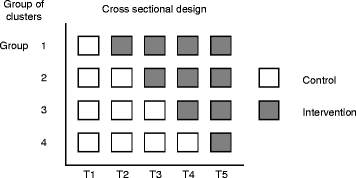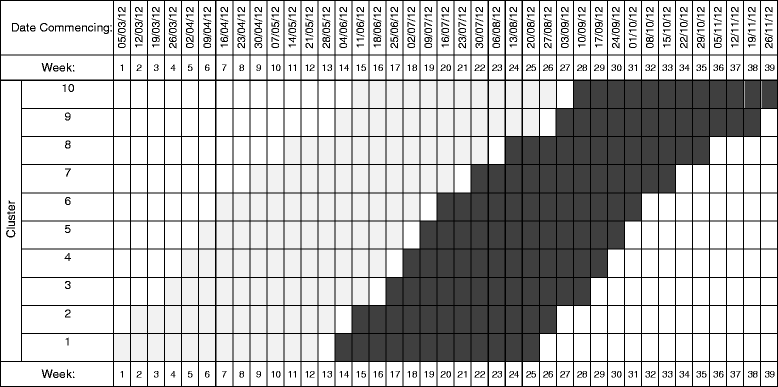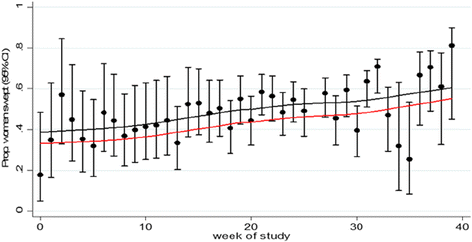Analysis of cluster randomised stepped wedge trials with repeated cross-sectional samples
- PMID: 28259174
- PMCID: PMC5336660
- DOI: 10.1186/s13063-017-1833-7
Analysis of cluster randomised stepped wedge trials with repeated cross-sectional samples
Abstract
Background: The stepped wedge cluster randomised trial (SW-CRT) is increasingly being used to evaluate policy or service delivery interventions. However, there is a dearth of trials literature addressing analytical approaches to the SW-CRT. Perhaps as a result, a significant number of published trials have major methodological shortcomings, including failure to adjust for secular trends at the analysis stage. Furthermore, the commonly used analytical framework proposed by Hussey and Hughes makes several assumptions.
Methods: We highlight the assumptions implicit in the basic SW-CRT analytical model proposed by Hussey and Hughes. We consider how simple modifications of the basic model, using both random and fixed effects, can be used to accommodate deviations from the underlying assumptions. We consider the implications of these modifications for the intracluster correlation coefficients. In a case study, the importance of adjusting for the secular trend is illustrated.
Results: The basic SW-CRT model includes a fixed effect for time, implying a common underlying secular trend across steps and clusters. It also includes a single term for treatment, implying a constant shift in this trend under the treatment. When these assumptions are not realistic, simple modifications can be implemented to allow the secular trend to vary across clusters and the treatment effect to vary across clusters or time. In our case study, the naïve treatment effect estimate (adjusted for clustering but unadjusted for time) suggests a beneficial effect. However, after adjusting for the underlying secular trend, we demonstrate a reversal of the treatment effect.
Conclusion: Due to the inherent confounding of the treatment effect with time, analysis of a SW-CRT should always account for secular trends or risk-biased estimates of the treatment effect. Furthermore, the basic model proposed by Hussey and Hughes makes a number of important assumptions. Consideration needs to be given to the appropriate model choice at the analysis stage. We provide a Stata code to implement the proposed analyses in the illustrative case study.
Keywords: Analysis; Cluster randomised trial; Secular trends; Stepped wedge.
Figures




Similar articles
-
Stepped-wedge cluster randomised controlled trials: a generic framework including parallel and multiple-level designs.Stat Med. 2015 Jan 30;34(2):181-96. doi: 10.1002/sim.6325. Epub 2014 Oct 24. Stat Med. 2015. PMID: 25346484 Free PMC article.
-
An imbalance in cluster sizes does not lead to notable loss of power in cross-sectional, stepped-wedge cluster randomised trials with a continuous outcome.Trials. 2017 Mar 7;18(1):109. doi: 10.1186/s13063-017-1832-8. Trials. 2017. PMID: 28270224 Free PMC article.
-
The fixed-effects model for robust analysis of stepped-wedge cluster trials with a small number of clusters and continuous outcomes: a simulation study.Trials. 2024 Oct 25;25(1):718. doi: 10.1186/s13063-024-08572-1. Trials. 2024. PMID: 39455982 Free PMC article.
-
Developing Statistical Methods to Improve Stepped-Wedge Cluster Randomized Trials [Internet].Washington (DC): Patient-Centered Outcomes Research Institute (PCORI); 2021 Aug. Washington (DC): Patient-Centered Outcomes Research Institute (PCORI); 2021 Aug. PMID: 38913814 Free Books & Documents. Review.
-
Analysis and reporting of stepped wedge randomised controlled trials: synthesis and critical appraisal of published studies, 2010 to 2014.Trials. 2015 Aug 17;16:358. doi: 10.1186/s13063-015-0838-3. Trials. 2015. PMID: 26278667 Free PMC article. Review.
Cited by
-
Effect of Tele-ICU on Clinical Outcomes of Critically Ill Patients: The TELESCOPE Randomized Clinical Trial.JAMA. 2024 Dec 3;332(21):1798-1807. doi: 10.1001/jama.2024.20651. JAMA. 2024. PMID: 39382244 Free PMC article. Clinical Trial.
-
Bayesian Hierarchical Penalized Spline Models for Immediate and Time-Varying Intervention Effects in Stepped Wedge Cluster Randomized Trials.Stat Med. 2025 Feb 28;44(5):e10304. doi: 10.1002/sim.10304. Stat Med. 2025. PMID: 39964677 Free PMC article.
-
Robust analysis of stepped wedge trials using cluster-level summaries within periods.Stat Med. 2018 Jul 20;37(16):2487-2500. doi: 10.1002/sim.7668. Epub 2018 Apr 10. Stat Med. 2018. PMID: 29635789 Free PMC article.
-
Identification of Anterior Large Vessel Occlusion Stroke During the Emergency Call: Protocol for a Controlled, Nonrandomized Trial.JMIR Res Protoc. 2024 Feb 13;13:e51683. doi: 10.2196/51683. JMIR Res Protoc. 2024. PMID: 38349728 Free PMC article.
-
Effectiveness of a multifaceted prevention programme for melioidosis in diabetics (PREMEL): A stepped-wedge cluster-randomised controlled trial.PLoS Negl Trop Dis. 2021 Jun 25;15(6):e0009060. doi: 10.1371/journal.pntd.0009060. eCollection 2021 Jun. PLoS Negl Trop Dis. 2021. PMID: 34170931 Free PMC article. Clinical Trial.
References
-
- Mdege ND, Man MS, Taylor (nee Brown) CA, Torgerson DJ. Systematic review of stepped wedge cluster randomized trials shows that design is particularly used to evaluate interventions during routine implementation. J Clin Epidemiol. 2011;64(9):936–48. doi: 10.1016/j.jclinepi.2010.12.003. - DOI - PubMed
-
- The Gambia Hepatitis Study Group The Gambia Hepatitis Intervention Study. Cancer Res. 1987;47(21):5782–7. - PubMed
MeSH terms
Grants and funding
LinkOut - more resources
Full Text Sources
Other Literature Sources
Medical
Research Materials

